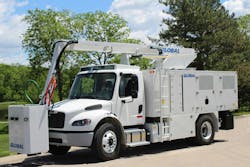Global Ground Support is reintroducing its G-1200 twin engine regional deicer for the upcoming 2024-25 winter season.
The redesign of the general aviation deicer, which first debuted in 1998 and was manufactured until 2014, prioritizes ease of operation and maintenance, and cost effectiveness.
“We took a holistic course of action when redesigning this asset, including asking what the business needs of the FBO market are; a population whose end users are often individuals who may need to deice infrequently. In addition, we thought extensively about the product’s full lifecycle, integrating simplicity with capability and longevity with ease of maintenance,” says Mark Stevenson, chief engineer, research and development, Global Ground Support.
The redesign process took a market-based approach with input from customers – including equipment operators and maintenance personnel – along with Global Ground Support’s engineering, production and service teams. Stevenson points out 80 percent of Global Ground Support’s production team has been with the company for 10 or more years and says these team members have become experts. He says that expertise, along with the simplicity of the design and a reduction in parts, makes the G-1200 a reliable piece of equipment.
The updated G-1200 uses standard, readily available components to maximize field support. In addition, Global Ground Support incorporated design elements such as weldments and body components from its other product lines to aid suppliers in producing parts.
“Our engineering team set out to make the truck as modular as possible, meaning that the electrical boxes, cables and components are all considered ‘plug and play.’ This feature is especially nice when troubleshooting issues as components can be easily removed and replaced, allowing for root causes to be quickly identified,” says Stevenson.
The G-1200 is made to service regional aircraft up to and including some B-737 series aircraft.
“We also see these units used for gate deicing when maneuverability is critical,” Stevenson adds.
The total fluid tank capacity is 1,200 gallons (1,000 gallons for Type I deicing fluid and 100 gallons for Type IV anti-icing fluid). In North America, these fluids are usually propylene glycol or ethylene glycol. Although Europe has slightly different chemical characteristics, Stevenson says, the G-1200 is ready to be used there also.
The deicing and anti-icing process begins typically with first applying deicing fluid to “wash” the snow/ice from the flying surface.
“Any contamination of the flight surfaces can severely impact the lift generated. Deicing fluid is immediately followed by a coat of anti-ice fluid to protect the flying surfaces prior to take off. This is done to meet holdover time requirements that vary based on weather conditions,” says Stevenson.
The G-1200 is capable of deicing both the wings and fuselage, depending on the size of the aircraft and the accumulation of ice and snow.
“With a light snowfall, on average of 60 to 120 US gallons are dispensed for larger aircraft, but it depends a lot on experience, ambient temperatures, wind, and if the engines are on or off,” he says.
Customers have reported an open bucket can quickly deice an aircraft on a pad or in an open area – in approximately 6 to 7 minutes if the contamination is easy to remove. At a gate, Stevenson says the process is a bit slower due to congestion. If a fuselage spray is needed, that can take additional time.
The fluid heating system can go from 0 to 180 degrees F in 15 minutes or less. Stevenson says this is important because “the quicker the fluid can be heated, the better in terms of flight schedules and operational efficiencies.” A touchscreen panel in the cab indicates the fluid temperature, amount dispensed and other measurements.
The Type I deicing fluid tank is insulated to reduce fuel usage. The insulation helps retain fluid heat during cold weather, enabling the heater to burn less frequently.
Other measures taken to minimize environmental impact include the fluid system design, which reduces the amount of horsepower needed to apply the fluid on the aircraft surfaces. “Reduced horsepower equates to increased fuel economy,” Stevenson explains.
If not properly managed, deicing fluid can have an environmental impact. Global Ground Support Glycol Recovery Vehicles (GRV-800 and GRV-200) can be used to reclaim glycol, which can then be processed and reused.
The maintenance schedule for the G-1200 consists of daily pre-operational inspections and routine servicing at 8, 50 and 250 hours, and an end-of-season inspection tailored to preventative maintenance (PM).
The G-1200 is available with a gas or diesel Ford chassis or diesel Freightliner chassis.
Standard features include an integrated fluid flow meter system for deicing and anti-icing, suction fill, reverse camera, auto-lube system, USB ports and accessory power points.
About the Author
Rebecca Kanable
Assistant Editor
Rebecca Kanable, a veteran journalist, worked with Endeavor Business Media's aviation group from 2021 to 2024 as assistant editor of Airport Business, AMT and Ground Support Worldwide. She previously worked for various publications, including trade magazines and newspapers.

